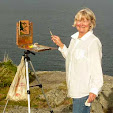Monhegan Skyline
If once you have slept on an island
You'll never be quite the same;
You may look as you looked the day before
And go by the same old name,
You may bustle about in street and shop
You may sit at home and sew,
But you'll see blue water and wheeling gulls
Wherever your feet may go.
You may chat with the neighbors of this and that
And close to your fire keep,
But you'll hear ship whistle and lighthouse bell
And tides beat through your sleep.
Oh! you won't know why and you can't say how
Such a change upon you came,
But once you have slept on an island,
You'll never be quite the same.
- Rachel Lyman Field
There are many more than five islands in Maine that you can visit by ferry, and I'm going to share my favorites in the next few posts. Perhaps these will help you with your summer vacation plans. At the top of my list is Monhegan, the artist's island, ten miles off the midcoast Maine shore.
"Monhegan" comes from the Algonquian Monchiggon, meaning "out-to-sea island." It was first visited by Europeans in the early 17th century and became a British fishing camp and trading post. The island was caught in the conflict between Britain and France for control of the region, but even during the times when the island was not inhabited, the protected harbor was a stopover for ships. The current lighthouse was built in 1850, after its 25 year old predecessor was damaged by storms. There is a wonderful museum in the Lighthouse Keeper's cottage.
House on Monhegan - Bobbi Heath
By 1890 the island was established as an artist's colony, which continues to today. Edward Hopper, Rockwell Kent, and Jamie Wyeth are names you've probably heard. What inspires artists to paint here? The light and the subject matter. Many places that are surrounded by water are wonderful for painters because the light bouncing off the water is everywhere, sparkling and giving life to the shadows. As to subject matter, the island is made up of the village, the harbor, forests, meadows, and the dramatic cliffs on the ocean side facing the Atlantic. There's plenty there to paint.
Monhegan is .7 mile wide and 1.7 miles long, and is not developed like the rest of the Maine coast. There are less than 80 year round
residents, a working lobster fishing village, and a thriving artist's community. The island
has no paved
roads and visitors cannot bring cars, but if you are willing to walk, you are in for a treat. Two thirds of the island is
protected as a nature preserve by the Monhegan Associates, "an island
trust which has accepted the responsibility of holding and maintaining
the land in its natural form, for all future generations to enjoy". Seventeen
miles of natural trails encircle and crisscross the island, through meadows and forests, onto the headlands, and
along the coves and ledges. Birdwatchers, nature lovers, and
photographers will all find something to interest them. You'll likely
see painters in both the village and on the ocean side cliffs. You can
download a trail map of the island, courtesy of the Monhegan Associates,
here.
How can you get there? Monhegan is served by ferries from three Maine harbors, from southwest to northeast, BoothBay Harbor (
Balmy Days Cruises), Round Pond (
Hardy Boat Cruises), and Port Clyde (
Monhegan Boat Line). You can visit for the day or longer.
Downtown Monhegan - Bobbi Heath
My recommendation for a day trip is to take a walk through the village and then visit the lighthouse, where you'll get a fabulous view of the village at your feet and the island of Manana, which makes up the other side of Monhegan's harbor. If you have time, continue past the lighthouse and walk through Cathedral Woods to White Head on the backside. To get a beautiful view of White Head, turn right on the trail and walk to Gull Cove. Alternatively, the walk to Lobster Cove is beautiful, and your rewards is the rocky cove and the remains of the wreck of the D T Sheridan. And FYI, these walks are somewhat rugged.
Where can you stay? The largest hotels/BnBs are the
Island Inn, the
Monhegan House, and the
Trailing Yew, each offering an experience unique from the others. And there are 11 rooms/homes listed on airbnb.com and vrbo.com at the moment.
And if you do visit Monhegan, please let me know how you found it.






